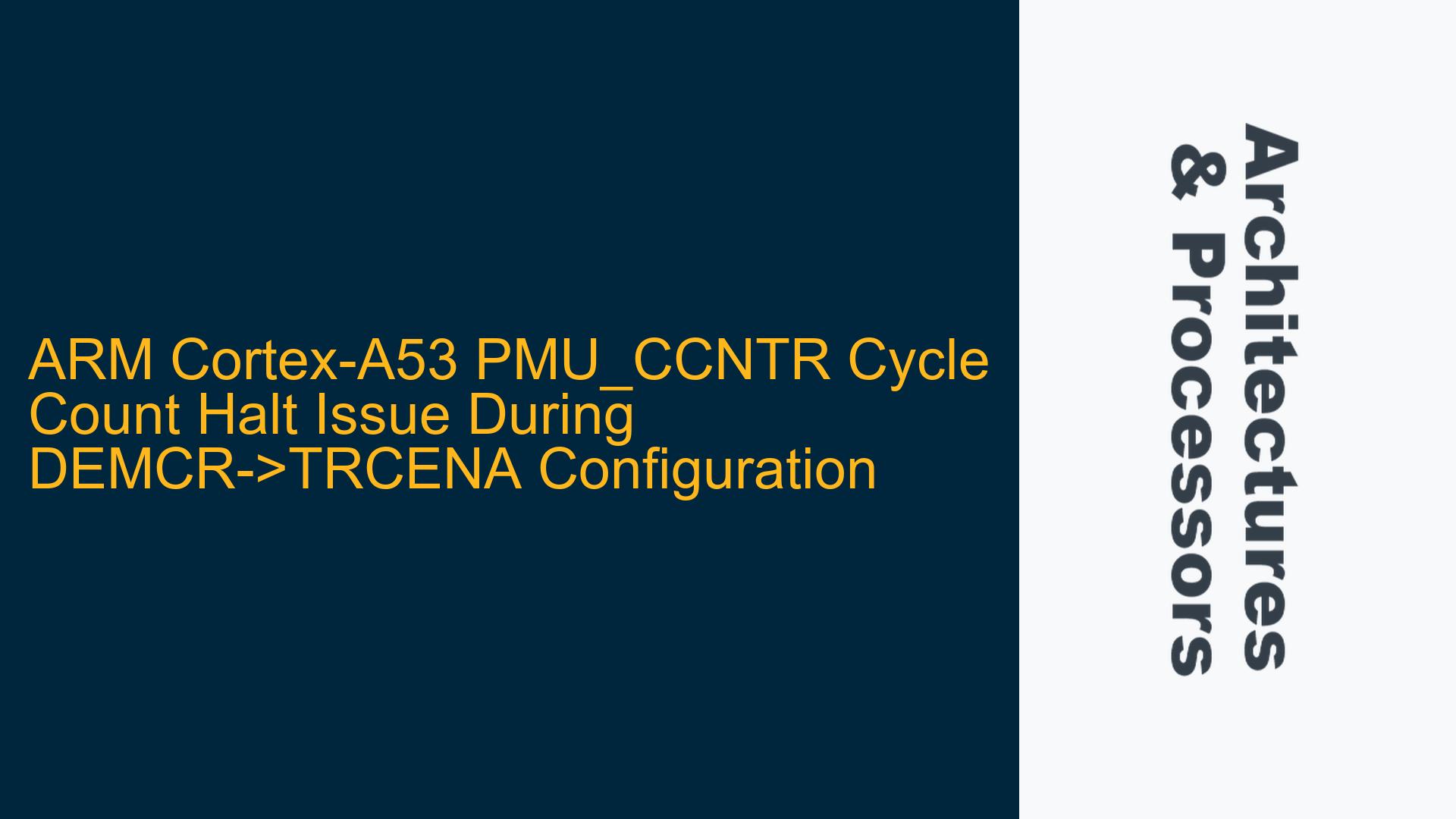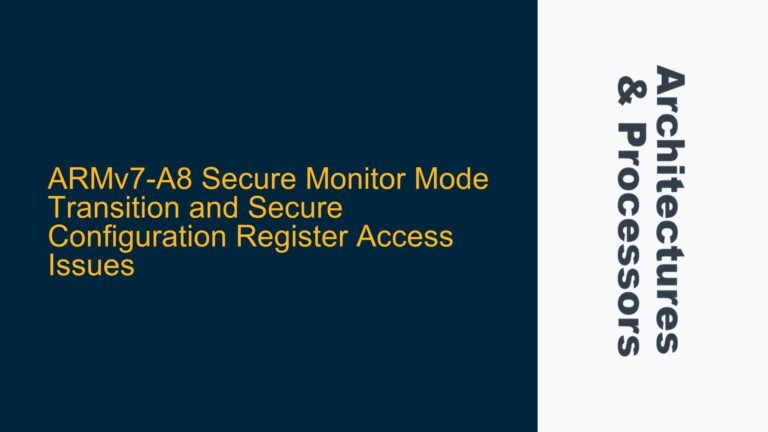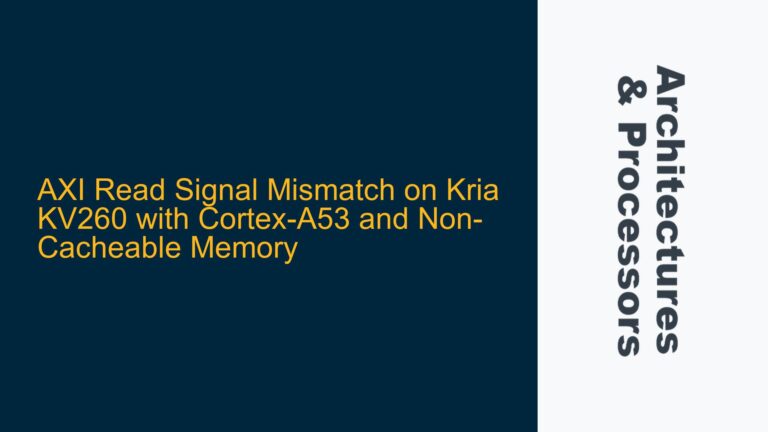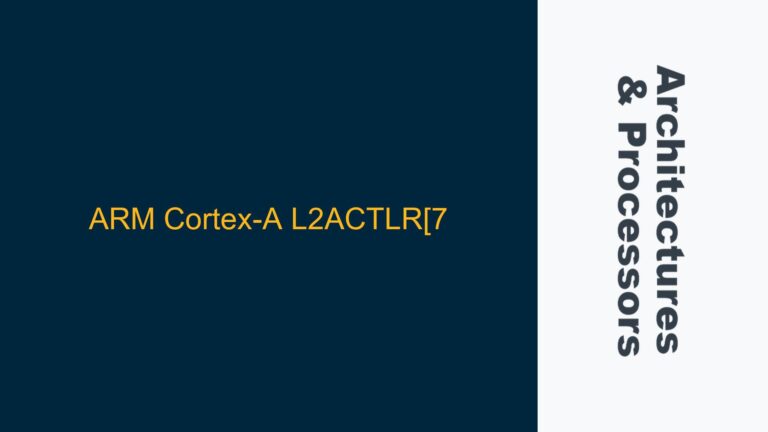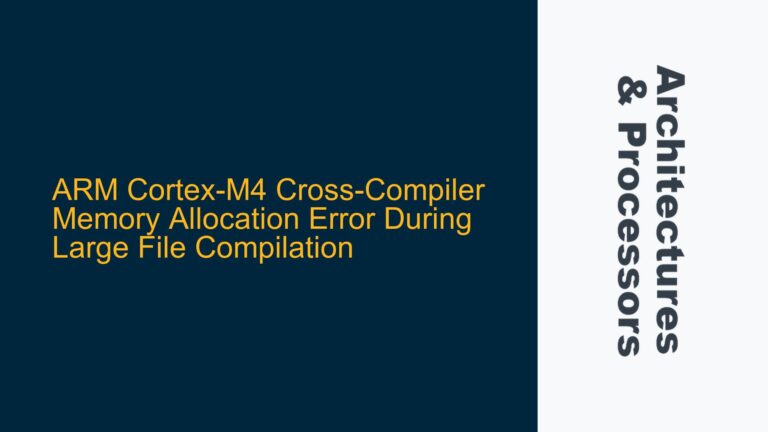ARM Cortex-A53 PMU_CCNTR Cycle Count Halt Issue During DEMCR->TRCENA Configuration
The ARM Cortex-A53 processor is a widely used 64-bit core in embedded systems, known for its balance of performance and power efficiency. One of its key features is the Performance Monitoring Unit (PMU), which allows developers to measure various performance metrics, including CPU cycle counts. The PMU_CCNTR (Performance Monitor Cycle Counter) is a critical register for tracking the number of CPU cycles executed. However, configuring the PMU_CCNTR requires enabling the PMU through the DEMCR (Debug Exception and Monitor Control Register) by setting the TRCENA (Trace Enable) bit. In some cases, writing to the DEMCR->TRCENA bit can cause the execution of code to halt, preventing the PMU_CCNTR from functioning as intended. This issue can be particularly challenging to debug, as it involves subtle interactions between the debug and performance monitoring subsystems.
DEMCR->TRCENA Bit Configuration and PMU Initialization Sequence
The root cause of the code execution halt during DEMCR->TRCENA configuration often lies in the initialization sequence of the PMU and the interaction between the debug and performance monitoring subsystems. The DEMCR register is part of the CoreSight Debug architecture, which provides control over debug and trace functionality. The TRCENA bit, when set, enables the use of performance counters, including the PMU_CCNTR. However, if the PMU or debug subsystem is not properly initialized before writing to the DEMCR->TRCENA bit, the processor may enter an undefined state, leading to a halt in code execution.
One common mistake is attempting to enable the PMU_CCNTR without first ensuring that the PMU is in a valid state. The PMU must be configured with the appropriate event counters and enabled before the DEMCR->TRCENA bit is set. Additionally, the debug subsystem must be initialized to allow access to the DEMCR register. If either of these steps is skipped or performed out of order, the processor may halt execution when the DEMCR->TRCENA bit is written.
Another potential cause is the presence of debug exceptions or breakpoints that interfere with the PMU initialization process. If a debug exception is triggered during the PMU configuration, the processor may halt execution to handle the exception, preventing the PMU_CCNTR from being enabled. Similarly, if a breakpoint is set on the code that configures the PMU, the processor may halt execution at the breakpoint, leaving the PMU in an uninitialized state.
Proper PMU Initialization and Debug Subsystem Configuration
To resolve the issue of code execution halting during DEMCR->TRCENA configuration, it is essential to follow a proper initialization sequence for both the PMU and the debug subsystem. The following steps outline the recommended approach:
-
Initialize the Debug Subsystem: Before attempting to configure the PMU, ensure that the debug subsystem is properly initialized. This includes setting up any necessary debug registers and ensuring that debug exceptions are handled correctly. If using a debugger, ensure that breakpoints are not set on the PMU initialization code.
-
Configure the PMU Event Counters: The PMU must be configured with the appropriate event counters before enabling the PMU_CCNTR. This involves selecting the events to be counted and setting up the PMU control registers. The exact configuration will depend on the specific performance metrics being measured.
-
Enable the PMU: Once the PMU event counters are configured, enable the PMU by setting the appropriate control bits in the PMU registers. This step ensures that the PMU is ready to start counting cycles when the PMU_CCNTR is enabled.
-
Set the DEMCR->TRCENA Bit: With the PMU and debug subsystem properly initialized, set the DEMCR->TRCENA bit to enable the PMU_CCNTR. This step should be performed after all other PMU and debug configurations are complete to avoid any conflicts or undefined behavior.
-
Verify PMU_CCNTR Functionality: After enabling the PMU_CCNTR, verify that it is functioning correctly by reading the cycle count and comparing it to expected values. If the cycle count is not incrementing as expected, review the initialization sequence and ensure that all steps were followed correctly.
By following this sequence, developers can avoid the issue of code execution halting during DEMCR->TRCENA configuration and ensure that the PMU_CCNTR functions as intended. Additionally, it is important to consult the ARM Cortex-A53 Technical Reference Manual for detailed information on the PMU and debug subsystem registers, as well as any errata that may affect PMU functionality.
Debugging and Troubleshooting PMU_CCNTR Issues
If the PMU_CCNTR is still not functioning correctly after following the proper initialization sequence, additional debugging and troubleshooting steps may be necessary. The following are some common issues and their potential solutions:
-
Check for Debug Exceptions: If the processor halts execution during PMU initialization, check for any debug exceptions that may have been triggered. Use a debugger to inspect the exception registers and determine the cause of the exception. If a debug exception is causing the halt, ensure that the exception handler is properly configured and does not interfere with PMU initialization.
-
Review PMU Configuration: If the PMU_CCNTR is not incrementing, review the PMU configuration to ensure that the event counters are set up correctly. Verify that the PMU control registers are configured as expected and that the PMU is enabled before setting the DEMCR->TRCENA bit.
-
Inspect DEMCR Register: If the DEMCR->TRCENA bit does not appear to be set correctly, inspect the DEMCR register to ensure that the write operation was successful. Use a debugger to read the DEMCR register and verify that the TRCENA bit is set. If the bit is not set, check for any issues with the write operation, such as incorrect register addressing or access permissions.
-
Check for Errata: Consult the ARM Cortex-A53 Technical Reference Manual and any applicable errata for known issues related to the PMU or debug subsystem. If a known issue is identified, follow the recommended workaround provided in the errata document.
-
Use Alternative Cycle Counting Methods: If the PMU_CCNTR cannot be made to function correctly, consider using alternative methods for cycle counting, such as using a timer or external performance monitoring tools. While these methods may not provide the same level of accuracy as the PMU_CCNTR, they can still be useful for measuring performance metrics.
By systematically addressing these potential issues, developers can resolve problems with the PMU_CCNTR and ensure accurate cycle counting on the ARM Cortex-A53 processor. Proper initialization and configuration of the PMU and debug subsystems are critical to avoiding code execution halts and ensuring reliable performance monitoring.
Conclusion
The ARM Cortex-A53 PMU_CCNTR is a powerful tool for measuring CPU cycle counts, but its proper configuration requires careful attention to the initialization sequence of the PMU and debug subsystems. Writing to the DEMCR->TRCENA bit without proper initialization can cause code execution to halt, preventing the PMU_CCNTR from functioning as intended. By following the recommended initialization sequence and addressing potential issues through debugging and troubleshooting, developers can ensure that the PMU_CCNTR operates correctly and provides accurate cycle counts for performance analysis.
